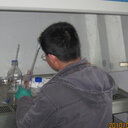PTP1B inhibitors from stems of Angelica keiskei (Ashitaba).
Mots clés
Abstrait
Three new chalcones, xanthoangelols K-M (1-3), together with 19 known compounds were isolated from the stems of Angelica keiskei Koidzumi, a well-known rejuvenated and anti-diabetic plant originated from Japan. The structures of compounds 1-3 were elucidated on the basis of spectroscopic data and Mosher's method. All compounds were evaluated for their inhibitory activity against protein tyrosine phosphatase 1B (PTP1B). Among them, six chalcones, xanthoangelol K (1), xanthoangelol (4), xanthoangelol F (5), 4-hydroxyderricin (6), xanthoangelol D (7), xanthoangelol E (8), and a coumarin, methoxsalen (17), showed strong PTP1B inhibitory effect with IC50 values of 0.82, 1.97, 1.67, 2.47, 3.97, 1.43, and 2.53μg/mL, respectively. A kinetic study revealed that compound 1 inhibited PTP1B with characteristics typical of a competitive inhibitor. Molecular docking simulations elucidated that ring B of 1 may anchor in a pocket of PTP1B and the molecule is stabilized by hydrogen bonds with Arg47, Asp48, and π-π interaction with Phe182 of PTP1B.


